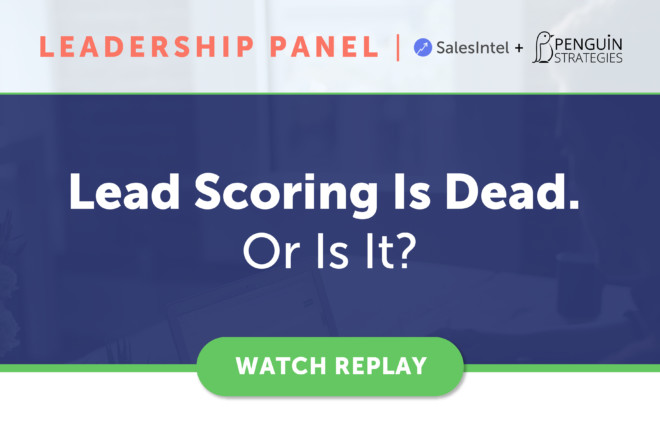Red hot leads are the ideal opportunities you want to get into the hands of your sales team. You want to grow your pipeline and close deals faster. And, your red hot leads are the highest value targets you have to help you hit your goals. These leads are the best fit for your company and where you can expect to win.
As we close out Q4 of 2023 and prepare for 2024, we want to have the best possible lead scoring and routing process in place.
We’re going to cover how to define these leads, why you should switch to a proactive “hunter” lead scoring model, and the process for scoring and routing your best leads to the top of your sales queue.
How Do You Define Your Red Hot Leads?
Everyone has their scoring model based on a lead’s personal and account criteria for how likely they are to close and how much attention they should receive from sales. These models follow general strategies regardless of company and evolve.
The baseline current scoring model is the MQL model. Based on marketing engagement and activity as well as persona and industry, the goal is to find prospects who fit your buyer persona and are showing direct interest in your product or service. The MQL model is why everyone has loved asking prospects to fill out forms with their title, company name, etc. You need the prospect to tell you they’re interested and worth your time for them to gain attention from sales.
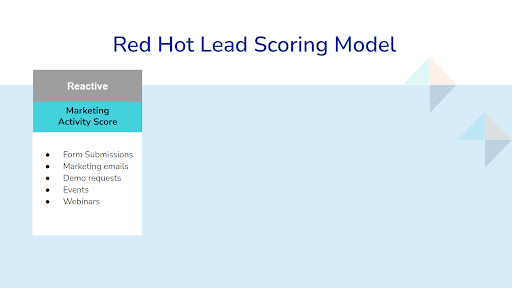
However, this model is evolving from a reactive model to using new data sources and gathering techniques to find hot leads before they interact with your brand proactively.
Instead of waiting for prospects to raise their hand and tell you they’re a good fit, the ideal leads can be found by creating your ICP (ideal client profile) and measuring how closely companies compare to your ICP based on firmographic, technographic, and internal deals won/lost data. MQL data is still included and useful, but you no longer have to wait for prospects.
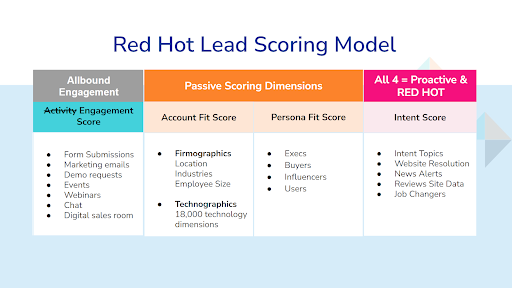
The final piece is buyer intent data to track which companies are actively researching your company and similar solutions. By combining intent data with your other data points, you can find qualified leads already in the marketing. No forms are needed.
The Benefits of a Hunter Lead Scoring Approach
With traditional MQL logic, which is the scoring off marketing activity, it’s highly reactive. You have to wait for leads to find you and fill out the form. Then you collect, process, and finally push prospects to your sales team.
Instead with the evolved hunter lead scoring model, you are proactive. Using a data partner like SalesIntel, you can layer in your ICP profile and intent data to pull a list of accounts in the market. You’re going from putting out your digital billboards and waiting to have a target list in hand for your sales team.
Now, you can drive highly targeted marketing and sales campaigns towards your best opportunities. Instead of thinking of engagement as a slow funnel the prospect moves down, and your whole revenue team (marketing, sales, customer success) works together to reach, close, and maintain relationships with your target customers. Your team is freed up to consider the full life cycle growth for each opportunity. Instead of waiting for each team to qualify and pass along, each team can find and contribute to revenue without being stuck waiting on the others.
As you take action, experiment, and learn from your customers, you’ll expand and revise your lead-scoring model at a faster rate than you could ever achieve with only MQL leads.
How Do You Get Started on Revising Your Lead Scoring Model?
Let’s walk through how we at SalesIntel went through our process of revising our lead scoring.
Everyone is likely comfortable and familiar with the MQL model. The next step is finding your account fit score/ICP criteria.
We went through this process and started with our firmographic and technographic customer data. We want to know where we tend to win deals so we can find similar accounts to go after. Make sure to also include customer life span and churn data as well. We found that we did best in the US market and had 20 industry verticals that stood out.
The next step is finding all the ways to keep narrowing down until you have your ICP. We layered on employee count, revenue thresholds, and technographics. You want to make sure a company is worth your time to pursue and has the technology in place to work with you.
Once we put everything together, we searched our database and found 26,000 companies that fit our ICP. Through analysis and testing, we discover that inside of our ICP, we have a 44% higher win rate. We have a 53% higher ACV when we close deals that are hitting our ICP. And, we have a 50% higher retention rate. We also tripled our three-year lifetime value with ICP customers.
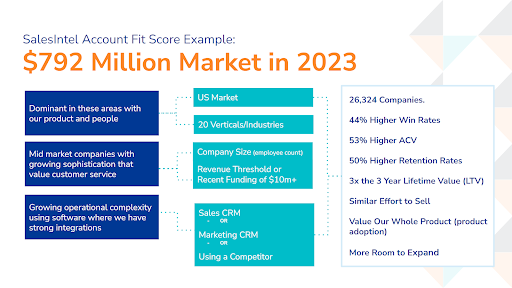
You might still have occasional MQL leads that come in, raise their hand, and are great customers despite not fitting your ICP. But, you’re only making ICP accounts your priority across all your teams for proactive outreach. Your sales, marketing, and the whole go-to-market team is thinking about this investment in the ICP and how we want to change our behavior.
Prioritization with Buyer Intent Data
So, where do you focus? How do you focus on the 26,000 companies we have? How do you focus on going after those accounts? You can’t without buyer intent data.
When we use intent data to see who is actively searching in the market, we find about 15% of those 26,000 companies are actively looking for a solution. From our experience, accounts that fit our ICP and show buying intent are three times more likely to close than accounts that don’t.
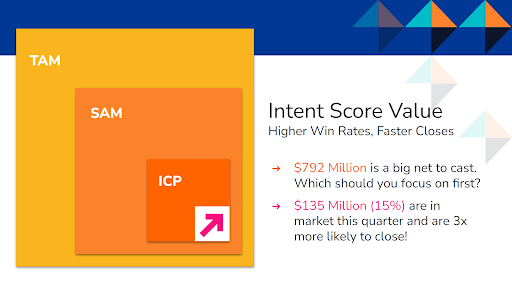
These accounts also close faster. We don’t have to take them through the whole buyer’s journey of identifying a problem, learning solutions, and then considering being in the market. We can skip the education segment of outreach because they’re already well aware of the problem they want to solve.
Intent data is the final piece along with your ICP criteria and classic MQL scoring to find your red-hot leads.
Think Through Your Lead Grading and Routing
Any revenue ops person is going to tell you that your scoring model 100% impacts your lead routing. How much of your resources can you parcel out to manage sets of leads? How much capacity do I have to handle a set number of leads?
Unfortunately, your hot lead list is rarely going to perfectly match your sales capacity. Maybe you have too many leads for your team to work promptly, so how do you continue to pick the best ones to work first? Or, maybe you don’t have enough leads that perfectly fit your criteria and need to figure out the second-best options to fill your team’s workload.
If you lack sales capacity then it’s time to narrow down your ICP again. If you can’t find any other data points where you tend to perform better then consider which opportunities would be best for long-term revenue growth.
If you don’t have enough red hot leads then you can grade your leads and have your teams go after the available leads in the next grade down from your perfect fit account with buying intent and marketing engagement. Next, you’ll want to target leads that fit your ICP and show intent regardless of marketing engagement. After that, it’s leads that fit your ICP and have engagement. Finally, your bottom tier would be leads that have MQL criteria or buying intent but don’t fit your ICP though these leads should be a last resort.
You’ll want to take the time to automate and set up your grading, routing system and and create lead tracking dashboards so each team can have their priority list with as little effort as possible on their end. If you build out your ideal lead list but sales can’t see who is on top to call each day then you want to be taking full advantage of the work you’ve done.
As you go and learn, you can increase the sophistication of your lead scoring. For example, did a company buy a competitor a year ago based on their technographic data? There tends to always be someone who doesn’t love a new piece of technology based on misaligned expectations and results. So, considering that one-year mark as a sign of possible buyer intent can help you find easy wins with minimal effort on your part. You could even automate the whole process to pull leads having been with a competitor for 10 months and send a marketing email to check on them with replies routed to your sales team.
Continually play and experiment with your lead grading and routing.
Bringing Your Teams Together for Proactive Lead Generation
All your teams need to work together to pull your data, analyze it, define your ICP, and stick with your new process. Everyone has to be on board as you test and optimize your buyer intent topics, ICP, lead routing, and messaging.
You have to work across teams or it’s not going to work. If one team doesn’t have buy-in, you run the risk of the whole thing falling apart. Switching to a new system is difficult. Success won’t happen immediately. Lessons will need to be learned. Everyone needs to be bought in and open to change.
But the ROI is on your side. Since we implemented the modern, proactive lead score and routing, we have had a 33% improvement in our outbound efficiency and a 102% improvement in our marketing inbound efficiency. In short, we had overall efficiency, we had lead volume efficiency, and then we had a closed conversion rate efficiency.
Improvement takes the willingness to change. Once all your teams are together, hot leads are coming in, and the deals start closing faster, you’re going to be happy you made the switch.




